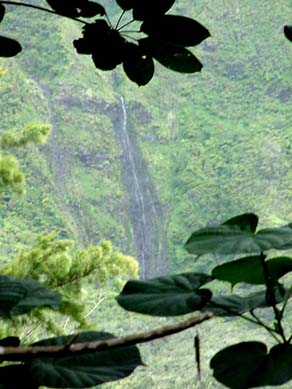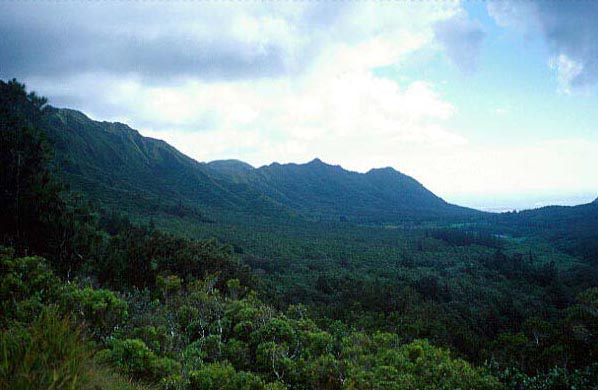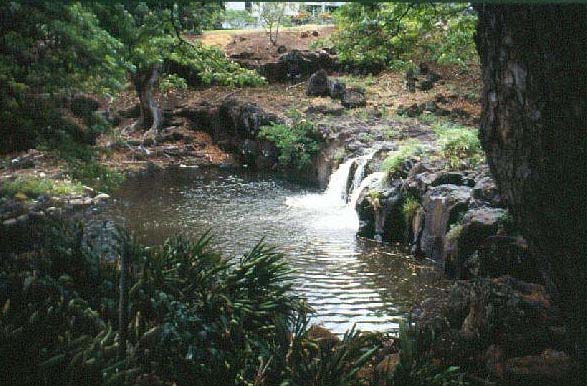 |
 |
 |
|||||||||||||||||||||
|
|
|
|
|
|
|
|
|
||||||||||||||||
|
|
|||||||||||||||||||||||
| |
|
|

Come land your craft at the harbor of Kou.
|
|
Honolulu ahupua‘a offers distinctly attractive features to early settlers. One is the natural harbor, formed by the outflow of fresh water from Nu‘uanu Stream. Because coral reefs require clean, salt water, there is a passage through the reef that leads into a sheltered bay. This feature was perhaps not so important to early Hawaiians, whose shallow-draft vessels could easily pass over the reef. But it became extremely significant in the establishment of Honolulu as the islands' center of international trade, and later as the official capital of the Kingdom. In terms of early settlement records, two hundred years of urbanization have obliterated most traces of what was once here. Most people agree that the lush valleys of Nu‘uanu and its neighbor Manoa would have been enticing. “Nuuanu was quite rich," states Puakea Nogelmeier, "but our physical, archaeological record that we have been able to map out is very spotty."
|
||
|
|
||
|
|
Conceptualizing the early times is always problematic. On the one hand, archaeologists present their schemes based on physical evidence. On the other hand is the Hawaiian oral tradition. Puakea explains: "Actually, what we have been able to test and check is very limited. It’s important to remember that when we’re trying to define timeframes and systems. One archaeologist proposes that ahupua’a sort of graduated: as the population reached a certain level of density or production, it became an ahupua‘a. He doesn’t go with the Hawaiian tradition that all of the ahupua‘a were established at once, that the boundaries were set. "Legend says that Ma‘ilikukahi set all the boundaries, sometime around the 1400s, 1500s, depending how you run the genealogies. It’s looked at as a governing system, and an economic system, as well as an ecological system. It makes sense that it would all have been applied at once. "It’s a brilliant conception to be able to rule the whole island and its total production, by name, from a single spot. You could sit, whether you were ruling from Kailua or from Waikiki, with a ‘aha, with a council of your chiefs and your land managers. You could, by name, award and collect taxes, and oversee every single district on the island. And really, you’d only have to talk to six people (one for each moku). It’s a brilliant system, and it seems that it functioned relatively intact for 400 or 500 years, which is longer than the States have functioned for the United States.”
|
|
|
|
|
Looking down Nu‘uanu from the ridge above the Pali.
|
|
"You have in Nu‘uanu, and down following the Nu‘uanu river, and in these valleys, that kind of ecosystem that you have on the Windward side" Jim Bartels explains. "Lush, perfect environments for traditional agriculture and settlement. Descriptions of immense, glistening taro ponds stretching as far as the eye can see from Nu‘uanu Stream are quite characteristic of the early days. How beautiful it was, the glistening water and the taro sprouts. It's a very rich ecosystem, with the fish ponds and taro patches, along the stream and moving outward. And there are other streams coming down, and then also you have Manoa and Pauoa valleys."
|
||
|
|
||
|
|
||
|
"Nuuanu shows up in all of the early god legends" Puakea continues. "Kane is always there, Ku, Kamapua‘a all have their places there. Because of such early references, it seems that Nu‘uanu would have been settled early on. To me, that speaks of antiquity. But that’s from a totally cultural perspective. I say to the archaeologists, you just have to keep digging! There’s just not enough mapping done." Some of the traditions of ancient peoples occupying this valley are discussed on the next page, The Ancients.
|
||
|
|
||
|
|
| |
|
|

|
| Nu‘uanu Home | Map Library | Site Map | Hawaiian Islands Home | Pacific Worlds Home |
|
|
|||
| Copyright 2003 Pacific Worlds & Associates • Usage Policy • Webmaster |
|||







